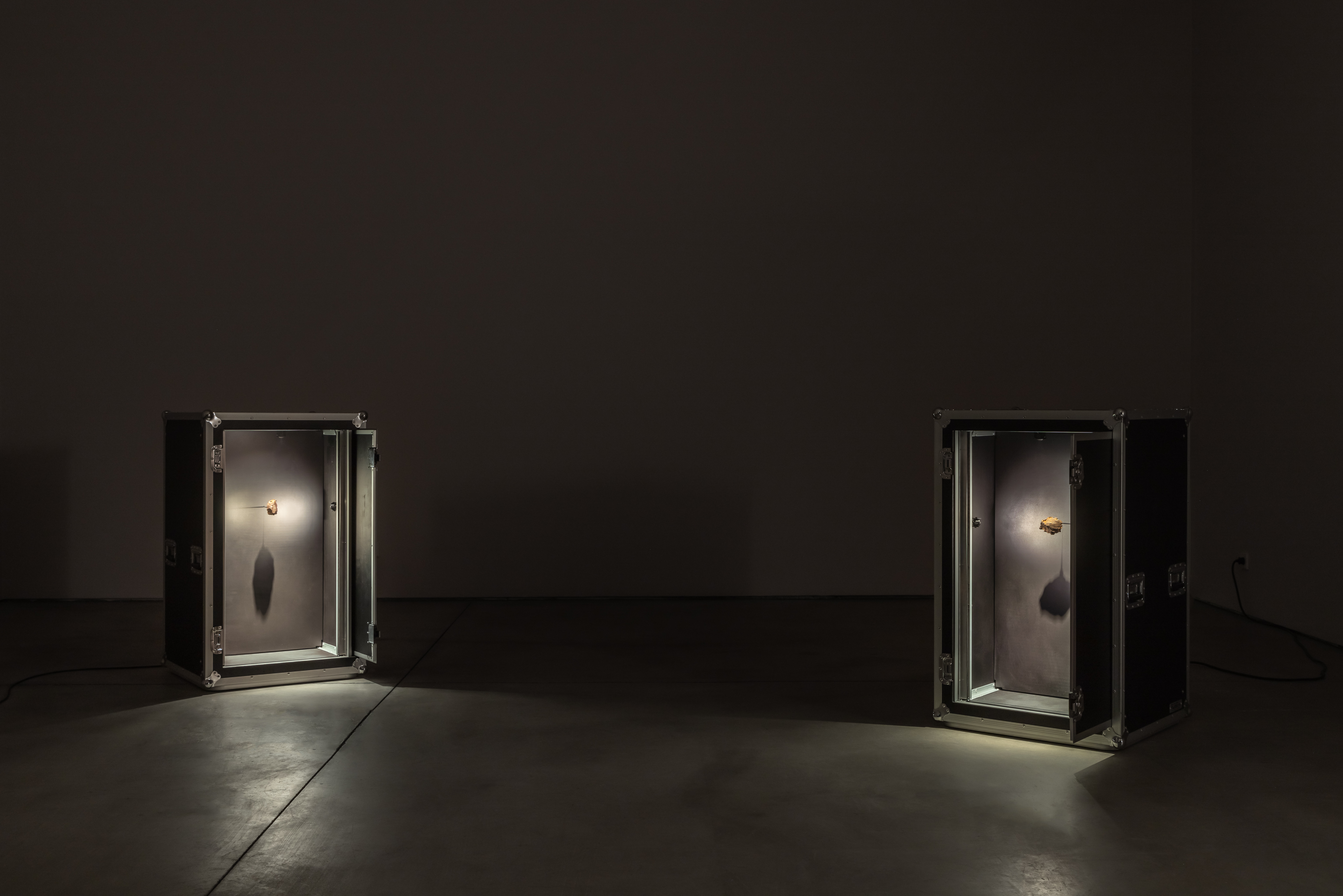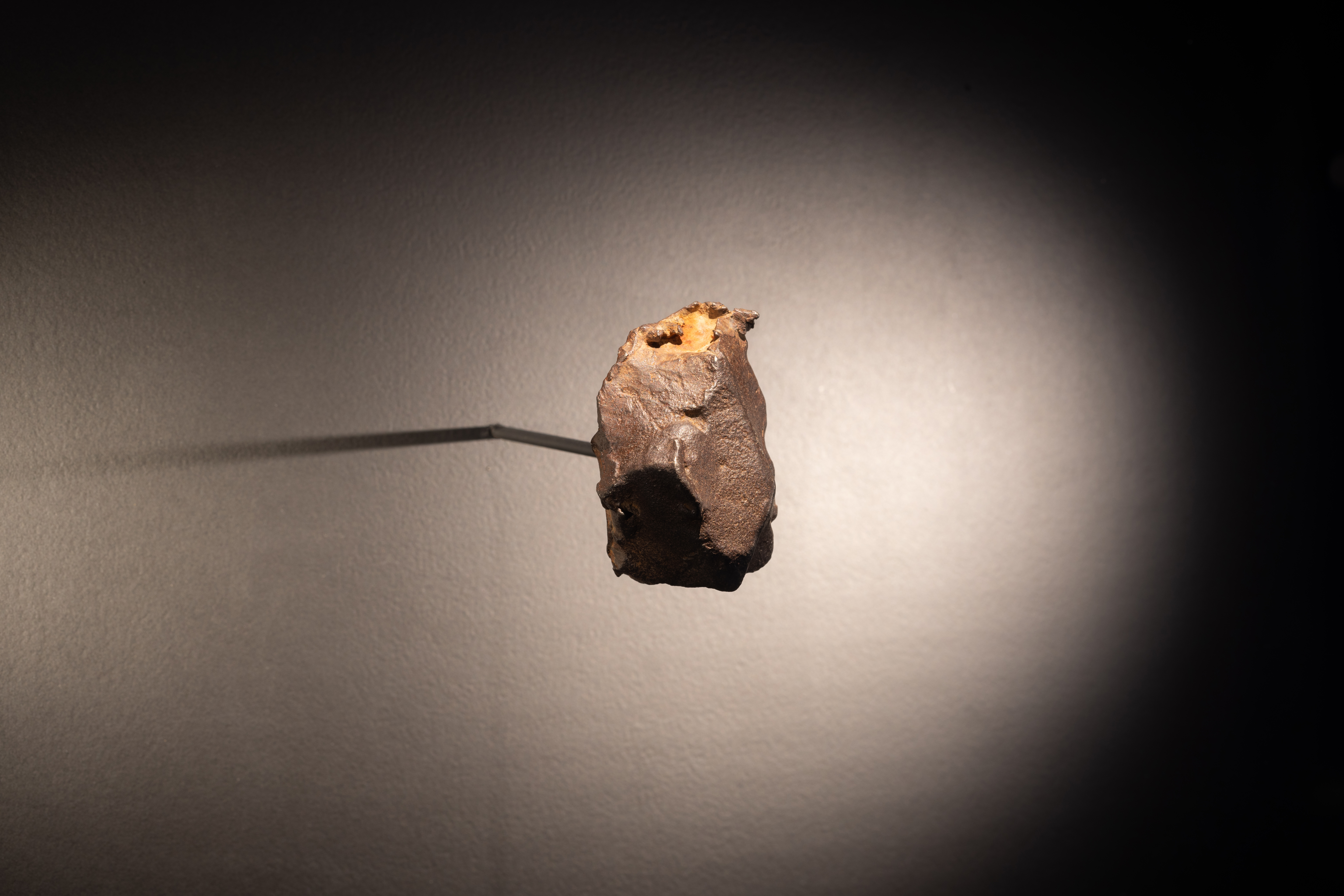





We choose and sacralise objects in order to review our eternity in them. In 1919, a new invention by 23-year-old Lev Sergeyevich Termen began to make a strange sound (1). As a result of a fault in the device he was developing, the theremin emerged as the first synthesiser in the history of electronic music, forever changing its course and the understanding of the musical instrument as an object reactive to the human magnetic field. Years later, around 1965, a young Tony Iommi lost the tips of two of his fingers in a work accident in a metal factory, precisely on what would be his last day at the job before surrendering to his musical practice. A moment of resistance in the face of the obvious adversity he faced — as well as a reluctant listening to Django Reinhardt's (2) latest album — encouraged him to create a prosthesis that would extend his stolen extremities. Determined to play his Gibson with an iron tip in place of the void, he developed what would become the unprecedented and characteristic sound of heavy metal (3) — a dense, sonic and predestined riff. In the coming century, in 2001, a group of Russian teenagers would select seven melodies to be transmitted by radio waves into deep space (4) in a loop. Due to its electromagnetic quality and its ability to generate micro-tunes at a continuous frequency, the theremin was the chosen instrument to play this fifteen-minute concert, believed to have the greatest affinity with any probability of life outside Earth. One of the tracks chosen was Gershwin's famous 1935 composition, Summertime — the tune with the most versions recorded in its documentary archive (5).
HEAVY METAL is an exhibition about a seismic cluster of phenomenological improbabilities. Giving sound to an interstellar journey in the exhibition space and summoning divine and ancestral symbols, Henrique Pavão (Lisbon, 1991) reflects on how the defects and failures that condition the intimate narratives of beings are transformed into omnipresent decipherments in a historical continuity, anachronistically intersecting in the same conceptual spectrum. By destroying and reorganising a cosmology of dissimilar references in the face of the consequence of randomness, the artist composes an ode to impermanence — where the mystique of sound, metallurgy and celestial objects are allied in a mantra to the entropic qualities of transformation. The key element and aggregator of all these energies is the duo of meteorites that solemnly levitates in the shimmering light within the installation.
Originally coming from the ancient Gebel Kamil crater, they are part of a collection of meteoric iron remains that has been scattered but surprisingly well preserved since it fell in Egypt more than five thousand years ago. Taking as his raw material the celestial sacredness attributed to these objects — which mythology, in fact, called star metal — Pavão collects them and returns them to the mystery of their origin, giving them a voice that paradoxically communicates to the void an eternal call between life and death — inside was the universe, may he protect you (6). We recognise the song that lulls them. We even recognise that it is Gershwin's original arrangement for his mythical opera, Porgy and Bess (1935), in which a mother sings her child to sleep on her lap, in a tenderness that is both tragic and melancholic, and which is presented here with the longing of a whale's song. We sense the distancing and pressing crescendo of a spectral cry, which momentarily escapes from space only to persistently return. The result of a process sculptured by the artist in the image of the accident that gave rise to the term Heavy Metal, the sound is played by an instrumentalist (Ângela Flores Baltazar) on a theremin whose magnetic waves are activated, not only by her hands, but mostly by the magnetic quality of the heavy (7) and distinct iron meteorites that musician held while playing. The extension of this body, in fact replaced by an object foreign to the viability of the performance — as in Iommi's case (8) — thus gives the work a strange and painful struggle regarding the dominance of the instrument which, being electromagnetised, removes from the very meteorites that give it voice all its magnetic charge — the only living proof, now gone, of its identity and provenance — imprisoning them in an encounter of mutual annulment and strangely relating their painful echo to the very fine soprano of the original opera.
Enclosed in boxes used to transport other musical equipment by air for concerts, modified here to make way for showcases, the meteorites await their journey as the monolithic instruments of this symphony of unveiling and prayer. Ghosts of their own origin and artefacts of their condition, they slowly await a path that can never begin, which is excellently summed up in the repetition of hearing the embezzlement that, in order to call them to life, erased them — it seems to make sense now, as one critic described the sound of a theremin as a cello lost in a dense fog, crying because it doesn't know how to get home (9). The sound, also looped, of the main melody, is frontally directed at them by a stage monitor whose factual purpose is to give the musicians back the sound they emanate live, once again reiterating the formal circularity of the organism and the purpose of cosmic destruction/devolution present in the exhibition — reinforcing a kind of funeral eulogy in perpetual movement.
One line of proverb — one verse of folk song
Half a child’s lullaby — one page of ancient poetry.(10)
Spectators of their own destruction, the meteorites are haunted by a final presence — the image of a frog that gazes absently over them throughout the rehearsal. Permeated with a resinous essence and uncovered by a torch that outlines its elusive contours within the confines of the same wood that often supports the necks of electric guitars, it recalls an old biblical parable from the Old Testament — Exodus 8:2 — often known as the plague of the rain of frogs11. This first conception — presented as an omen of punishment and therefore reverberating a divine intervention in the convalescence of evil — is rebelled against by its Egyptian meaning, naturally summoned by the impact crater, we know, of the celestial objects themselves, in a kind of mystical solidarity with Heaven (12). Symbolising feelings of goodness, abundance, fertility and forgiveness, it would often be an image of company to a body on its journey after death — here suggesting a kind of vital continuity, or perhaps even a promise of resurrection. To the meteorites that encase it, godspeed.
Eva Mendes, 2024
(1) Weiner, Sophie in Russian Espionage and Electromagnetic Fields: The Story of the Theremin, 2017
(2) Jean "Django" Reinhardt was a Romanian-French guitarist whose fourth and fifth fingers were damaged by a violent burn.
(3) Initially used to characterise the sound of Black Sabbath's first album in 1970, on which Tony Iommi was lead guitarist.
(4) The mission is known as "Teen Age Message" and refers to the artist's dedication to his nephew Joaquim.
(5) To date, more than 25,000 versions of this song have been recorded.
(6) Chandaka, verses from Two Cosmologies, 6th century B.C. Translated by W.S. Merwin and J. Moussaieff Masson.
(7) The meteorite on the right hand weighs 341.27 grams and the one on the left 276.07 grams.
(8) Tony Iommi also doesn't feel the strings he plays on his prosthetic fingers.
(9) Comment on the YouTube video where Lev Termen "plays his own instrument." https://www.youtube.com/watch?v=w5qf9O6c20o
(10) Inrasara, verses of Allegory of the Land. In The penguin book of spiritual verse, Penguin Classics, 2023.
(11) The very title of the photograph, "It's not going to stop", refers to the frog rain sequence in Paul Thomas Anderson's film Magnolia (1999).
(12) Eliade, Mircea in Ferreiros e Alquimistas, Zahar Editores, 1977.
Heavy Metal, 2024
Photo — Bruno Lopes
Video Documentation:
https://vimeo.com/1087988600
Heavy Metal, 2024
Iron meteorite Gebel Kamil (provenance: Al Wadi al Jadid, Egypt, 2009 (276,07gr) - IMCA#2093 – GMA #0052, iron meteorite Gebel Kamil (provenance: Al Wadi al Jadid, Egypt, 2009 (341,27gr) – IMCA #2093 – GMA #0052,
(2x) Flyht Pro Rack 20U Slide Shock (modified), (2x) magnet plates, stage monitor 800W, sound (“Summertime” by George Gershwin played on Theremin with iron meteorites (one for each hand), continuous loop)
Variable dimensions
Thereminist: Ângela Flores Baltazar
Mix: Henrique Pavão & Benjamim
Recorded at: studio louva-a-deus, Lisboa (with Benjamim)
Flyht Pro Racks modification: ArtWorks
It’s Not Going to Stop, 2024
Silver gelatin print on paper, rosewood
76,2 x 51,2 cm
© 2025 Henrique Pavão